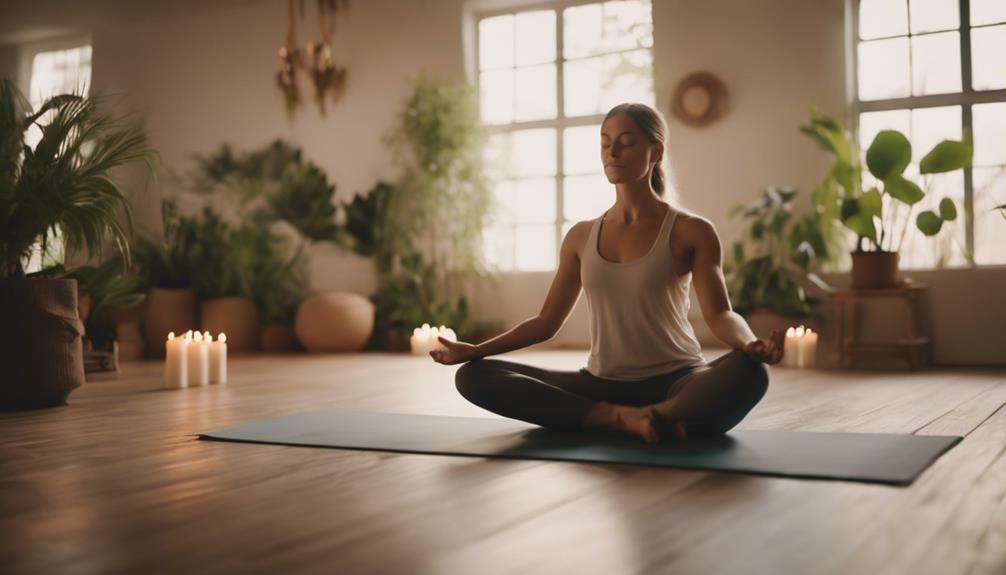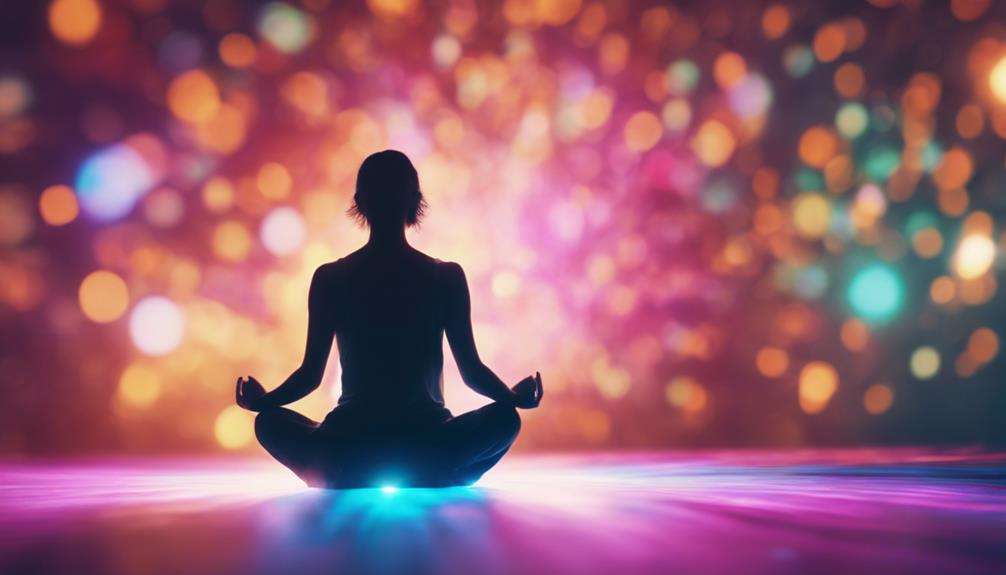Imagine embarking on a journey through a lush forest, each step bringing a sense of calm and tranquility.
As you explore the realm of Yoga Nidra for stress relief, you'll uncover a treasure trove of practices that can soothe your mind and body.
Discover how these ten carefully curated techniques can offer you a pathway to serenity and relaxation, guiding you towards a state of inner peace and rejuvenation.
Key Takeaways
- Yoga Nidra reduces stress levels and improves sleep quality.
- It boosts immune system function and enhances emotional well-being.
- Yoga Nidra lowers blood pressure and reduces chronic pain.
- It fosters mental health benefits, spiritual growth, and self-discovery.
Body Scan Technique
Begin your Yoga Nidra practice with the Body Scan Technique to systematically focus on different body parts for relaxation and stress relief. The body scan method involves starting from your right foot and gently shifting your awareness upwards, taking note of each body part along the way. As you mentally scan each area, pay attention to any sensations present and allow yourself to release any tension you may be holding. By observing without judgment or attachment, you can foster mindfulness and a deeper connection between your body and mind.
This practice isn't just about physical relaxation; it also aids in reducing discomfort, improving the quality of your sleep, and enhancing your overall well-being. Through the body scan technique, you can learn to listen to your body's signals, address areas of tension, and promote a sense of calm and ease. Embrace this opportunity to tune into your body, letting go of stress with each breath and each scan.
Guided Visualization
Visualizing peaceful scenes or positive outcomes can be a powerful tool in reducing stress and creating a sense of calm. By engaging your senses and immersing yourself in serene landscapes or healing energies, you can enhance relaxation and promote emotional well-being.
Let's explore the benefits of visualization, techniques for beginners, and how it can help you tap into your body's natural relaxation response.
Benefits of Visualization
Engaging in guided visualization during Yoga Nidra can transport you to serene mental landscapes, fostering relaxation and healing. By creating a mental image or scene, visualization techniques help stimulate the creative part of your brain, promoting deep relaxation and inner peace.
When you imagine peaceful landscapes, soothing colors, or positive affirmations, your mind shifts away from stressors, allowing you to cultivate a sense of calm. Regular practice of guided visualization during Yoga Nidra can significantly enhance your overall well-being and mental clarity.
Embracing the benefits of visualization not only aids in stress relief but also empowers you to tap into the healing power of your mind, fostering a profound sense of tranquility and balance.
Techniques for Beginners
Guided visualization in Yoga Nidra offers beginners a gentle introduction to relaxation and mental clarity through the power of imagery. As a beginner, following a guided script can help you stay focused and relaxed during your practice. By visualizing calming scenes like a beach or a forest, you can effectively reduce stress and anxiety.
Deep breaths while imagining these peaceful settings can enhance your relaxation response and deepen the connection between your mind and body. This technique not only calms the mind but also promotes inner peace.
Embrace guided visualization as a beginner to experience the soothing benefits and gradually ease into the practice of Yoga Nidra for stress relief.
Enhancing Relaxation Response
Ease into a deeper state of relaxation and mental clarity by incorporating guided visualization techniques into your Yoga Nidra practice. When you visualize peaceful scenes like serene beaches or lush forests during Yoga Nidra, you invite your mind and body to relax deeply.
Imagine vivid details – the colors of the sky, the feel of the sand beneath your feet, the sound of gentle waves – to enhance the experience. Engaging all your senses through visualization helps calm your nervous system, reducing stress and promoting a profound sense of inner peace.
Deep Breathing Exercises
As you embark on deep breathing exercises during Yoga Nidra, remember to focus on slow, deliberate breaths to promote relaxation.
Notice the sensation of coolness on your inhale and warmth on your exhale to cultivate mindfulness and calmness.
Embrace the importance of being present in the moment with each breath, allowing yourself to unwind and destress effectively.
Benefits of Deep Breathing
Engage in deep breathing exercises during Yoga Nidra to activate your parasympathetic nervous system, promoting relaxation and reducing stress. Deep breathing improves oxygen flow to your brain, enhancing mental clarity, focus, and cognitive function.
By practicing deep inhalations and exhalations, you release tension from your body, calm your nervous system, and lower your blood pressure. These techniques can also alleviate symptoms of anxiety, depression, and insomnia.
Consistent deep breathing fosters a sense of inner peace, emotional balance, and overall well-being. Embrace the power of deep breathing as a tool to nurture your mind and body, paving the way for a more relaxed and stress-free life during your Yoga Nidra practice.
Techniques for Relaxation
Indulge in the soothing practice of deep breathing exercises during Yoga Nidra to promote relaxation and relieve stress. To enhance your relaxation experience, focus on breath control techniques that can deepen your sense of calm and improve your overall well-being.
Here are some techniques to help you master the art of relaxation through deep breathing:
- Practice slow and deliberate inhalations and exhalations
- Focus on the cool sensation when inhaling and warmth when exhaling
- Incorporate pauses after exhales to calm the nervous system
- Return to natural, effortless breathing after deep breathwork
- Utilize breath control techniques to deepen relaxation and improve awareness
Importance of Mindfulness
Enhance your mindfulness practice through deep breathing exercises in Yoga Nidra by focusing on the soothing rhythm of your breath. Mindfulness in Yoga Nidra involves paying attention to the breath flowing in and out, engaging in deep, slow inhalations and exhalations.
By honing in on the sensations of coolness during inhalation and warmth during exhalation, you can deepen your mindfulness experience. Practicing slow breathing with intentional pauses after exhales promotes relaxation and heightened awareness.
Transitioning back to natural, effortless breathing after controlled breathing helps in further relaxation and mindfulness. Embrace the calming power of deep breathing exercises to center yourself, reduce stress, and cultivate a profound sense of presence during your Yoga Nidra practice.
Progressive Muscle Relaxation
To experience the benefits of Progressive Muscle Relaxation, start by focusing on sequentially tensing and relaxing different muscle groups. This technique is a powerful way to release physical tension, promote deep relaxation, and reduce stress. By paying attention to each muscle group, you can enhance your body awareness and calm your nervous system effectively.
Here are some key points to remember when practicing Progressive Muscle Relaxation:
- Begin by finding a quiet and comfortable space to lie down.
- Start at your toes, gradually working your way up through different muscle groups.
- As you tense each muscle group, hold the tension for a few seconds before releasing it.
- Focus on the contrast between tension and relaxation to deepen the relaxation response.
- Remember to breathe deeply and rhythmically throughout the practice to enhance the overall experience.
Incorporating Progressive Muscle Relaxation into your Yoga Nidra routine can significantly contribute to a comprehensive stress relief experience.
Setting Intention and Affirmations

Setting intentions and affirmations in your Yoga Nidra practice can profoundly impact your subconscious mind and enhance your journey towards transformation and healing.
When it comes to relieving stress and tension in the upper back, incorporating specific affirmations can be particularly beneficial. Affirmations like 'My upper back is strong and relaxed,' or 'I release all tension held in my upper back' can help target this area of the body during the practice.
By focusing on these positive statements, you're directing your mind to release any built-up stress and tension in the upper back, promoting a sense of ease and relaxation in that area.
The power of affirmations lies in their ability to rewire your beliefs and behaviors, making it easier to let go of physical and emotional burdens. Consistently practicing affirmations during Yoga Nidra can lead to significant shifts in how you hold tension in your upper back and ultimately improve your overall well-being.
Yoga Nidra for Better Sleep
If you struggle with getting a good night's sleep, practicing Yoga Nidra can be a game-changer.
By engaging in deep relaxation techniques, you can improve your sleep quality significantly.
Embracing the mind-body connection benefits of Yoga Nidra may just be the key to unlocking a restful and rejuvenating night's sleep.
Deep Relaxation Techniques
Through the practice of Yoga Nidra's deep relaxation techniques, you can experience profound calmness that paves the way for restful and rejuvenating sleep. By engaging in progressive body relaxation from toes to head, you allow tension to melt away, preparing your mind and body for a night of deep rest.
Focusing on breath awareness and body scanning during Yoga Nidra sessions helps release stress and anxiety, creating the ideal conditions for peaceful sleep. Guided imagery and visualization techniques further enhance this relaxation, guiding you into a tranquil mental space perfect for falling asleep effortlessly and staying asleep throughout the night.
Setting a Sankalpa related to peaceful sleep can amplify the benefits of your Yoga Nidra practice, promoting stress relief and improved sleep quality.
- Progressive body relaxation
- Breath awareness and body scanning
- Reduction of insomnia and anxiety
- Guided imagery for a tranquil mental space
- Sankalpa for peaceful sleep
Improving Sleep Quality
To enhance your sleep quality and experience deep relaxation, incorporating Yoga Nidra practices into your bedtime routine can be highly beneficial. Yoga Nidra helps in lowering stress hormones that disrupt sleep patterns, allowing you to fall asleep faster and enjoy more restorative sleep.
By focusing on calming the mind and body, this practice creates a state of profound relaxation ideal for promoting better sleep. Specifically, if you struggle with discomfort in your lower back that affects your sleep, Yoga Nidra can help alleviate tension in that area, contributing to a more comfortable and undisturbed night's rest.
Improving your sleep through Yoga Nidra can lead to increased energy levels, better mood, and enhanced cognitive function, ultimately benefiting your overall health and well-being.
Mind-Body Connection Benefits
Enhance your sleep quality and experience deep relaxation by exploring the mind-body connection benefits of Yoga Nidra for better sleep. Here are some key points to consider:
- Yoga Nidra helps in calming the nervous system, leading to lower heart rate and blood pressure for a peaceful state conducive to restful sleep.
- Practicing Yoga Nidra before bedtime can release tension in the body and quiet the mind, aiding in falling asleep naturally.
- The guided process of Yoga Nidra resolves inner conflicts, reduces anxiety, and promotes inner peace, improving sleep patterns.
- Regular practice of Yoga Nidra boosts melatonin production, regulating the sleep-wake cycle for a more rejuvenating sleep experience.
- By focusing on the lower abdomen during practice, you can deepen relaxation and enhance the mind-body connection for better sleep.
Chakra Balancing Practice
Engage in the practice of chakra balancing during Yoga Nidra to align your body's energy centers and cultivate harmony within. Within the practice of chakra balancing, you'll focus on the seven main energy centers in your body, each corresponding to different aspects of your being. By bringing attention to these chakras, you can release any blockages that may be hindering the natural flow of energy, promoting a sense of overall well-being.
During your Yoga Nidra session, visualize each chakra vividly, paying attention to its associated color, location, and unique qualities. This visualization technique can enhance the balance and energy flow within your body, fostering a deeper connection to yourself and the world around you. By incorporating chakra balancing into your practice, you may experience profound relaxation, inner peace, and a heightened sense of awareness. Embrace this opportunity to harmonize your energy centers and embark on a journey towards holistic well-being through the power of chakra balancing during Yoga Nidra.
Mindfulness Meditation Integration

Explore the profound benefits of integrating mindfulness meditation into your Yoga Nidra practice to deepen relaxation and foster inner peace. By incorporating mindfulness techniques, you can enhance your present moment awareness and elevate your overall experience. Here are some ways in which mindfulness meditation integration can benefit your practice:
- Focusing on your breath helps center your mind and body, promoting a sense of calm.
- Tuning into different parts of your body during Yoga Nidra enhances body awareness and relaxation.
- Observing your emotions without judgment allows for greater emotional regulation and well-being.
- Mindfulness integration during Yoga Nidra can reduce rumination, leading to a clearer and more peaceful mind.
- Combining these practices can deepen your relaxation experience and cultivate inner peace that resonates long after your session ends.
Embrace the opportunity to connect with yourself on a deeper level through mindfulness meditation during your Yoga Nidra practice.
Sankalpa (Intention) Development
Developing your Sankalpa in Yoga Nidra involves crafting a heartfelt intention that aligns with your true nature and aspirations. Your Sankalpa is a powerful tool that can steer your life towards positive transformations. When formulating your Sankalpa, ensure it resonates deeply with your core values and desires. Remember, stating your Sankalpa in the present tense, as if it's already unfolding, can effectively engage your subconscious mind.
Repetition plays a crucial role in reinforcing your Sankalpa during your Yoga Nidra practice. By repeating your intention, you embed it into your subconscious, enhancing its potential to manifest in your life. Choose a Sankalpa that speaks to your soul and reflects what you genuinely seek. This alignment between your Sankalpa and your innermost aspirations can amplify its impact in guiding your journey. Embrace this process with openness and trust, allowing your Sankalpa to blossom and influence positive changes in your life.
Gratitude and Loving-Kindness Meditation

Incorporating gratitude and loving-kindness meditations into your Yoga Nidra practice can significantly enhance your emotional well-being and inner peace. Gratitude meditation in Yoga Nidra involves focusing on things you're thankful for in life, promoting positivity and joy.
Practicing loving-kindness meditation during Yoga Nidra entails sending wishes of love, compassion, and well-being to yourself and others. These practices help shift your focus from stressors to positive aspects, fostering emotional resilience and inner peace.
Regularly integrating gratitude and loving-kindness meditations can cultivate a mindset of appreciation and kindness towards oneself and others. This can enhance your overall well-being, reduce anxiety, and improve your mental health.
Embrace these practices with an open heart during your Yoga Nidra sessions to nurture a sense of gratitude and compassion within yourself, spreading positivity and kindness to those around you.
Frequently Asked Questions
Does Yoga Nidra Reduce Stress?
Yes, Yoga Nidra reduces stress. Case studies demonstrate its effectiveness. It relaxes your mind and body, lowering cortisol levels. By practicing regularly, you'll manage anxiety, insomnia, and feel more at peace. Embrace this practice for improved mental health.
What Happens if You Do Yoga Nidra Everyday?
When you practice Yoga Nidra daily, you experience a multitude of benefits. Daily benefits include improved sleep, reduced stress, enhanced focus, and a deeper mind-body connection. Embrace this practice for a calmer, more centered you.
What Are the 5 Stages of Yoga Nidra?
Embark on the journey of Yoga Nidra with its 5 stages: Preparation, Sankalpa, Rotation of Consciousness, Breath Awareness, and Visualization. Dive deep into each phase to nurture your mind, body, and spirit through these practice techniques.
How Do I Get the Most Out of Yoga Nidra?
To get the most out of Yoga Nidra, focus on deep breathing, set a positive intention, and engage in guided visualization. Allow yourself to fully immerse in the practice, embracing relaxation and awareness for optimal benefits.
Conclusion
As you conclude your yoga nidra practice, remember that you're like a lotus flower emerging from the murky waters of stress and tension, blossoming into a state of peace and tranquility.
Embrace the power of relaxation, set positive intentions, and cultivate a strong mind-body connection. With each breath, you're nurturing your inner garden, allowing yourself to bloom and thrive.
Keep practicing and watch yourself grow in strength and resilience. You deserve this moment of peace.






